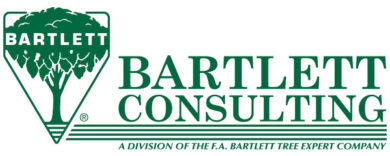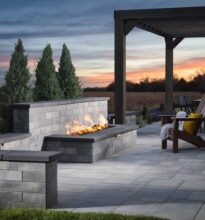Made For The Shade
By Laura Drotleff and Don Eberly
The Rimbou Venus acts like a giant leaf, providing shade for each chaise and giving residential and commercial space owners unique uses of their spaces.
Photo courtesy of Umbrosa / ShadeScapes AmericasIncorporating shade devices in landscape designs is no longer an afterthought, thanks to the increasing availability of sophisticated technologies and architectural options. Rather than scrambling to find a means for shade products to match the chosen outdoor furniture at the time of project conclusion, shade structures are becoming an integral part of the whole design. According to Jo Edmondson, co-owner of ShadeScapes Americas, a company that offers May, Woodline and Umbrosa collections of high-end shade products, advanced decisions regarding shade for exterior spaces have paramount significance.
“When planning for site design or installation, shade is thought of as the focal point more than it used to be,” Edmondson said. “When we began our business eight years ago, designers were putting money into all elements of landscape design, but there weren’t a lot of high-end shade options to live up to the rest of the design. Now, our landscape customers tell us that shade umbrellas and shade sails are a crucial design element.”
Gareth Mahon, a senior associate at Robin Key Landscape Architecture in New York City, has first-hand experience with creating shade in exterior spaces. “Whereas many landscape contractors and architects formerly struggled to include shade products, today’s umbrella options do not detract from the eye and are functional enough that they can be removed or put away when not in use,” he said.
His firm prefers to use shade products that offer a clean, contemporary style with flexibility in color and fabric. “Particularly with the ones we use, the shade cantilevers over the space and can be positioned off to the side and opened without getting in the way. It’s a very functional, pleasing look and design.”
Planning ahead
As with any element of outdoor design, a professional landscaper needs to assess a space’s shade conditions. By first determining how and when the client’s outdoor space will be used, all other aspects of planning can be aligned. In most climates, shade is vital, either to allow homeowners and their guests to completely enjoy the outdoor space, or to encourage customers to stop and linger at a cafe or hotel pool. Once an outdoor space has been completed, other than rain, shade is the most significant element that affects whether or not a space can be used to its fullest degree. “It doesn’t matter how beautiful a landscape is if people can’t enjoy it,” Edmondson said. “Incorporating the right amount of shade is crucial to people’s use and enjoyment of a setting.”
According to Mahon, important considerations include which direction the area faces, what time of day shade is needed, and how the space will be used when shade is not necessary. “Aesthetically, consider the relevance of color, style, fabric and shape. Also, it is recommended to consider the product options, umbrella or awning or shade structure,” he said. “If the client opts for a non-permanent shade product, such as an umbrella, think about how it will look and feel when it is in use and when it is not.” He also advises to predetermine the shade product’s ability to be moved and stored out of the way.
Taking good measurements, assessing potential angles and mounting options, and learning about structural requirements are critical to the installation’s success. Designers should visit the construction site before making a final determination about the product. Then, and only then, might it be best to present options to customers based on structural and aesthetic needs.
Mahon’s firm develops many rooftop terrace designs, which involves working with building codes, anchoring requirements, and being mindful of waterproof membranes in the structures. “We have to take structural capacity and wind into account when designing shade for a rooftop garden setting,” he said. “If we’re designing something big and permanent, such as a pergola or shade structure, it can’t be too heavy for the roof because it will cause structural problems. Many buildings won’t allow structures to be attached, especially in small spaces, so finding the right solution depends on the client’s taste and building requirements.”
Mahon says he has used rooftop terrace products similar to ShadeScapes’ Piccolo and Pendulum umbrellas, both part of the Woodline Collection, as well as the Paraflex umbrella system from Umbrosa. “These work well because they are very functional, and when they are not being used, they are easily moved or retracted.”
For areas where shade from the sun is essential for use of the space, umbrellas that can be angled provide higher levels of flexibility for the homeowner or guests of a hotel or resort.
Photo courtesy of Woodline Picollo / ShadeScapes AmericasNoticing new trends
Style, functionality and versatility are foremost in high-end outdoor designs. With many customers now preferring umbrellas without a center post, side post and cantilever umbrellas are catching on in residential and public applications. “Another popular growing trend is the need for expansive shade areas for the “chat group” furniture concept,” Edmondson says. “We are watching a growing trend in outdoor couches, oversized chairs, and modular furnishings to accommodate gatherings. Designers need to be able to shade these large gathering areas and can accomplish this with stylish, architectural umbrellas that are as functional as they are beautiful,” she said.
Quality is a factor, as always, with commercial and residential clients adverse to replacing high-end furniture or umbrellas every couple of years. People are staying in their homes longer and, as with interior design, homeowners and business owners are often going for a 10-year design in their outdoor areas. Simultaneously, they want all elements of the design to last just as long. Umbrellas are being thought of in the same caliber as high-end furniture, with some designers even choosing umbrellas prior to deciding on furniture and other outdoor elements. “It’s a change of perspective, working from the top down instead of the foundation up,” said Edmondson. “More designers are thinking of shade in the earlier phases of design, and on the commercial side, shade is the most important consideration since it helps create the most usable space.”
Where contemporary design is involved, clients are seeking unique and sculptural products that offer the “wow factor,” such as the country club in North Carolina that is installing 60 Rimbou Venus shades this spring. “The Rimbou Venus, part of the Umbrosa Collection, offers personal shade for each chaise,” said Edmondson. “While these forms of shade are still new to the United States, this kind of flexibility and styling is catching the eye of designers who specify for contemporary projects.”
Finding shade solutions
Mahon and Edmondson agree that staying informed about the evolving shade products and systems on the market is an important part of providing solutions to residential and commercial space clients. “Professional landscapers can often mix and match from different collections for spaces with multiple or challenging areas,” said Edmondson. She and her staff members work with landscape designers to find ways that yield creative shade coverage, often resulting in strategic and unexpected approaches. This can involve wall and side post umbrellas, creating umbrella clusters using the Paraflex system, or combining shade solutions from two different lines. Mahon believes remaining creative during the preplanning phase like this is a good practice to design the ideal solution for a space.
Edmondson sees the trend leaning toward a switch from inexpensive shade umbrellas and the more permanent shade structures, such as pergolas and awnings, to many of today’s new offerings in creative shade. In part, this is due to the fact that the higher-end, less permanent shade solutions offer more functionality, along with customizable options. “For example, we make sure to offer multiple finishes in each of ShadeScapes’ three lines, allowing clients to choose finishes that match or complement their existing color palettes and furniture designs,” she said.
In essence, the latest technologies in mounted or anchored umbrellas with cantilever functionality or retractable versatility define a livable outdoor space. As such, these products can either be permanently attached or anchored, with the flexibility of still being movable. Or, they can be fashioned to make the umbrella look like it is part of the natural space, seemingly coming out of a large planter or garden. The end objective is to enhance or invent a space that offers a beautiful, yet flexible, experience for the owner.
As the economy continues to show signs of recovery and “on-hold” projects are being brought back to life, demand for outdoor renovations that include shade options is on the rise. This presents the revitalization of an important sales channel for those working in landscape design and installation.
Don Eberly is president/CEO of Eberly & Collard Public Relations, specializing in marketing businesses in the home, garden, design, landscape, and agribusiness industries. Laura Drotleff is a writer for the firm. They can be reached through www.eberlycollardpr.com
For more information visit www.shadescapesusa.com
Editor’s note: In the March issue of Landscape and Irrigation, page 18, the caption did not match the photo on that page. The correct photo and caption pairings are shown in this online version above. Landscape and Irrigation regrets any confusion this error may have caused.


